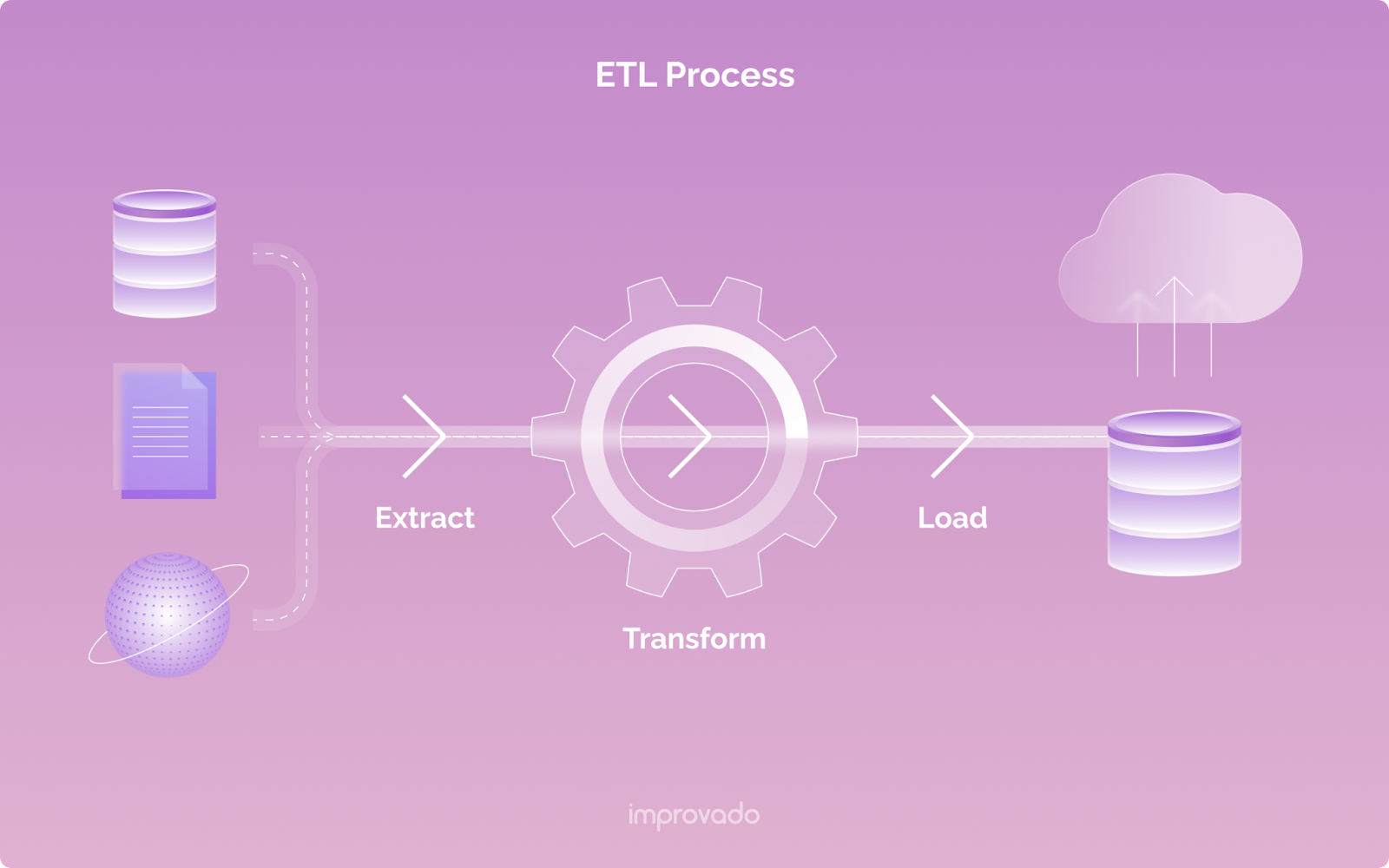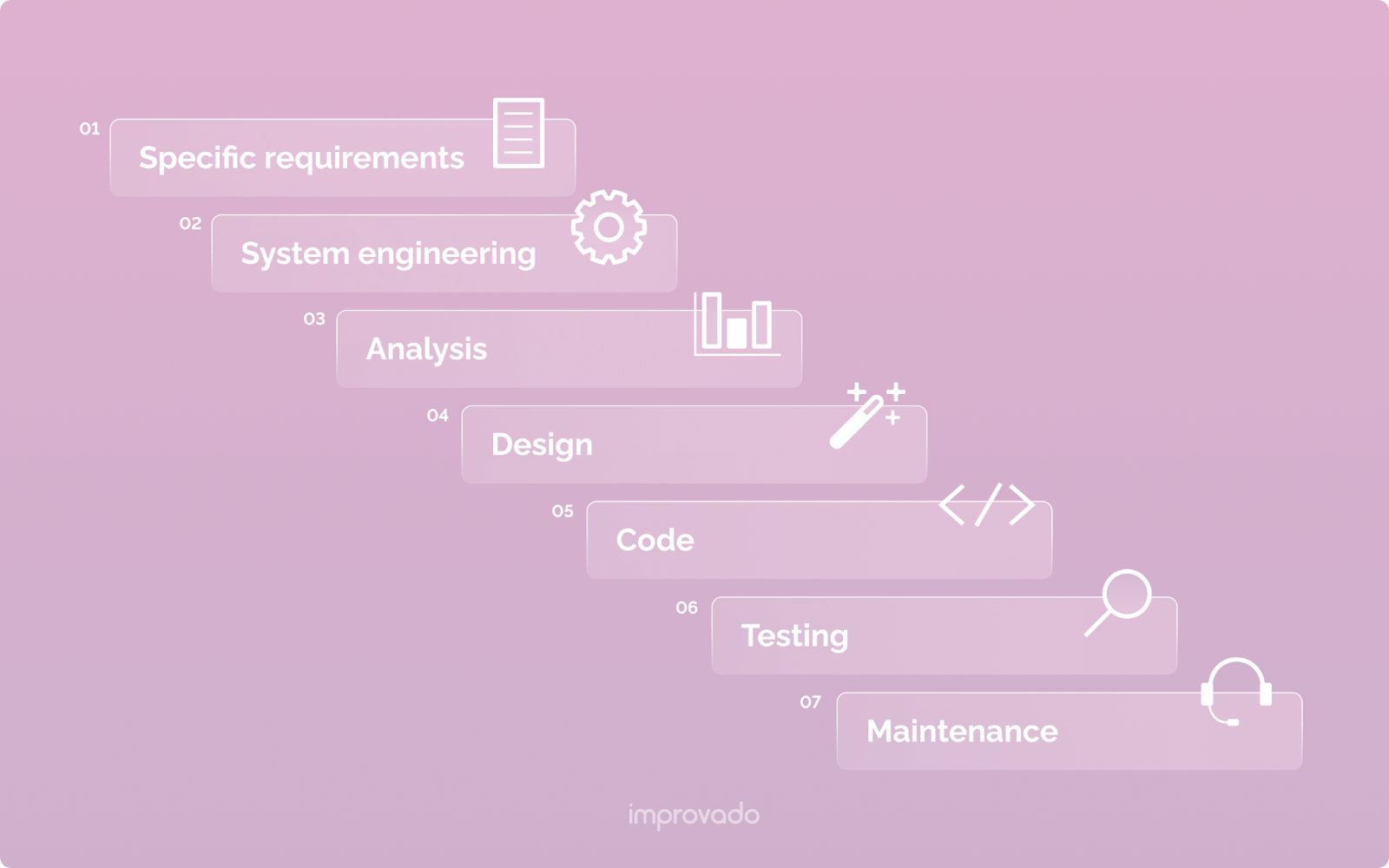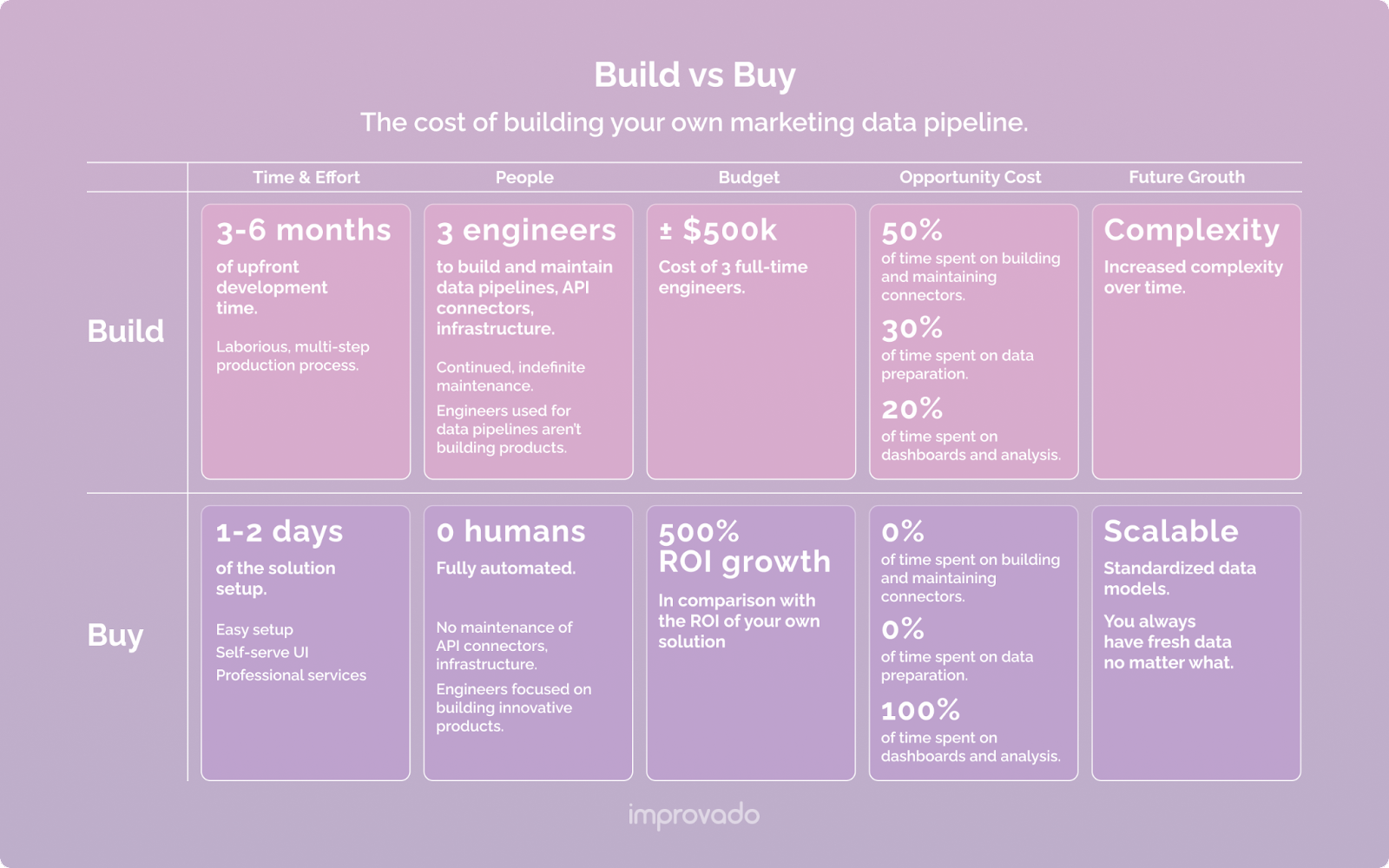Data needs have evolved very quickly for businesses over the past decade, with estimates for the global data market to reach 180 zettabytes by 2025.
In this business transformation, robust data infrastructure is one of the key elements for ensuring the large volumes of data an organization collects don't remain an under-utilized asset. Facing a technological barrier, companies encounter a dilemma: whether to build a data pipeline, namely ETL, in-house or buy a ready-made solution.
Understanding the pros and cons of both solutions and what reputational and security risks malfunctions in data pipelines pose will help you make the right choice for your company.
Key Takeaways
- ETL pipelines consist of three distinct processes: the extraction of data, its transformation, and the loading of data to your choice of destination.
- Building an ETL requires extensive human resources, upfront costs, and continuous maintenance.
- Buying an ETL gets you near-instant access to the most-used data sources with fewer inputs from your teams.
- Pre-built pipelines scale easily and meet industry compliance requirements.
- As data grows in potential value, companies need quick data wins to make sound business decisions and stay competitive.
Marketing ETL Building Blocks
ETL, or extract, transform, and load, is the process in which data is extracted from one or multiple sources, transformed, and then loaded into an endpoint.
👉 A Beginner's Guide to ETL Processes: ETL Stages and Benefits Explained
The major components that ensure the free flow of data through each phase are:
- Data source connectors: To gather data from Google Ads Manager, Shopify, Twitter Ads, or any other data source, you first need to establish a connector, usually an open API. Some applications don't provide open API or use raw files. An ETL solution must be able to process multiple data formats.
- Extraction layer: A complicated piece of software that pulls data from source locations to a staging area, where it awaits the next phase in the pipeline. The extraction layer leverages the API to fetch data, but the difficulty comes in fetching the data correctly, on time, according to the latest API version and internal and external requirements. The critical thing here is to support the extraction layer with a durable tech stack. Large marketing departments can ingest 50k rows of data and more. If the backend can't process this amount of data, the final output might be fractured or contain incomplete data.
- Transformation engine: Takes raw data, often in unusable or disjointed formats, and reformats it into consistent value types to prepare it for analysis. The most common types of data transformation include cleaning, deduplication, standardization, and more. Considering that most marketers don't have experience in SQL (often used to apply transformations), the engine needs a clear and concise UI.
- Loading logic: The final stop on the ETL pipeline, where transformed data is loaded to its final destination: a BI, visualization or analytics tool, or a data warehouse. It's highly usable and should integrate easily with the visualization solution of your choice.
All components mentioned above should also scale as the company and its data needs grow.

This is a high-level description of the ETL system’s building blocks. The question is whether you should hand-code them or opt for buying a ready-made solution.
Upfront Investment of Buying vs. Building an ETL
There’s so much more to the cost of an ETL than just the price tag.
Building an ETL
Engineering bandwidth and cost are the first things to consider. A project of this size and complexity will take months to complete, with costs piling up.
In addition, most ETL projects require a significant amount of cloud storage in a data warehouse, which is a cost in both the building and buying scenarios. However, when building your own, you must also figure out the logistics of procuring additional data warehouse management services, including how to budget for the costs of scaling up and down when needed.
After creating and implementing the system, expect to spend time and budget on training materials to keep your teams up to date on how to run transformations, connect data sources, and get the most out of the data presented.
Buying an ETL
The cost of buying an ETL is a bit more straightforward. You have one monthly or annual service plan price, so you don’t need to come up with development staff, cloud service upgrades, or extensive training to understand ETL infrastructure.
Onboarding resources, such as user guides and technical documentation, are included. New training docs are constantly being added, so you won’t have to use additional internal resources.
Development Complexity
Building an ETL pipeline is a labor-intensive, technically challenging task in itself. Building an ETL for a marketing department requires marketing expertise, which developers coming from product teams may lack.
Building an ETL
When creating your ETL, developers spend a lot of time and energy in the initial connection of data sources. Then, APIs often need tweaking to work for your homegrown systems, if APIs are offered at all. It’s also likely that a platform won’t have an API, forcing your developers to pull data in other ways.
What happens when you identify a data source to include in your pipeline? Data integrations can take up to 6.5 weeks of implementation time, assuming no errors occur and your infrastructure is up to date and secure.
As new API connectors are added, expect more time waiting for that data, as they aren't a plug-and-play event. Expect some possibly bad data to sneak in there from time to time since people make mistakes.
And that's only one component of the ETL pipeline.
Buying an ETL
Purchasing an ETL frees you and your dev team from the long to-do list of creating or adapting every API you use, every transformation you apply, or the destination you connect.
Back to the API example: once the pipeline is set up, you can choose your data sources from the list and connect in a matter of clicks. As new data source connectors are added, accessing and viewing data is almost immediate.
What happens if you want to pull data from an application that the vendor doesn't support? Reputable companies can handle these, as well—in far less time than if your developers were creating the connector. Improvado, for instance, has a Data Extraction Customization Services (DECS) credit system. A customer gets DECS credits and can use these credits on custom APIs, file ingestion, and other extraction needs.
Maintenance Costs
Everything needs maintenance, and your ETL pipeline is no exception.
Building an ETL
No matter what you do, new costs are assumed every time you maintain your technology. This happens when:
- Data sources change output or connection methods, which happens quite often. For example, the Google Ads API depreciates with the release of each new version, which leaves no other choice than to migrate to a new API. And the average lifespan of a version is 12 months.
- The way you use data changes.
- How the data you use changes concerning other data.
- Compliance measures require you to update your processes or data storage.
There’s such a need for assistance in helping in-house pipelines migrate data that entire businesses have been built on this type of support.
Buying an ETL
What happens when you purchase your pipeline and something needs to be fixed? The vendor handles it automatically as part of their update process. As data source outputs change, the technology gets upgraded for you, and industry regulations also stay top of mind.
Buying a data pipeline gets you access to support teams to help with any tech requests or issues you may encounter, thus reducing maintenance headaches as you scale.
Opportunity Cost
Data loses value over time, as acknowledged in this paper on time and perishability. Every moment spent building or tweaking pipelines and not collecting usable data leads to a decrease in the value of that data to your business.
Building an ETL

Long roll-out times—including testing and deployment—mean data perishes while you figure things out. This will leave you less competitive than other businesses in your industry who may have data ready to go at the push of a button.
It’s not uncommon for an ETL to take months, or even years, from the concept stage to turning out usable data. If other businesses in your niche are already acting on data, it won’t take long to fall behind.
Buying an ETL
Only you can define what business data means to you, but the global business analytics software market reached $67 billion in 2019. With so much invested in capturing and parsing data, businesses that skip to the front of the line with a purchased data pipeline may create more value than competitors.
With a pipeline ready to disseminate data, you can use it immediately in the way that best guides your business decisions.
Risks and Other Security Concerns
An incredible 21% of business files stored in the cloud contain sensitive data. Your choice of data pipeline should consider how much of your data could be at risk without rigorous security measures.
Building an ETL
Continued change in compliance regulations, such as healthcare or finance, means continual updates to your pipeline and a possible maintenance nightmare to stay legal and protect the important data of your customers and partners. The cost of data audits alone can skew the price of pipeline development, but adding in the potential fines for violating data protections and compliance rules is also a real financial and reputational risk.
Buying an ETL
With a pre-built pipeline, compliance is baked in, and there’s no need for your developers to learn regulatory best practices outside of their competencies and then tweak things to be compliant.
As industry requirements—such as HIPAA or SOC 2—change, your pipeline automatically updates to meet them, even in cases where you’re not following the changes yourself.
Banking, healthcare, and the social service industries are a lot to keep up with. You can’t even begin to anticipate how changing regulations put pressure on your teams to stay compliant, but a pre-built pipeline takes this stress away.
Performance and Scalability
Many factors affect performance, from infrastructure to human error.
Building an ETL
When you build your own ETL, the process is fraught with opportunities for human error. . For example, it takes just one misspelling to derail an entire data source.
On top of that, each new source requires writing new code, testing, deployment, and format conversion—a very inefficient use of your developers’ time that could discourage scaling at pivotal moments.
You may see delays in getting data results due to cloud connection errors or processing resources on your end. You are solely responsible for keeping things running well.
Buying an ETL
Infrastructure gets pushed onto the vendor, so you aren’t tasked with keeping all cloud computing resources onsite or paying for multiple cloud vendors. You can also scale up at any time to receive access to more rows, connectors, and more.
Why ETL Shouldn’t Be DIY
Many business leaders are innovative, apt, and motivated to take a DIY approach to ETL pipelines. With the uncertainty of the labor markets, high resource cost, and the indisputable fact that data degrades over time, waiting to handle things on your own can put you at a significant market disadvantage.

Choosing a pre-built ETL from Improvado grants you access to fresh data, putting you in a position to make significant business decisions about today’s markets.
With over 300 data integrations (and growing), you can mix and match sources to get a full view of customer journeys, financials, ad spend, and more, all without the compliance headaches and ongoing maintenance costs associated with going it alone.
As the markets, regulations, and data sources change, Improvado will adjust its processes to keep up with data integrity and security requests. It’s the ideal choice for businesses that value data-driven decision-making.
.png)



.png)
